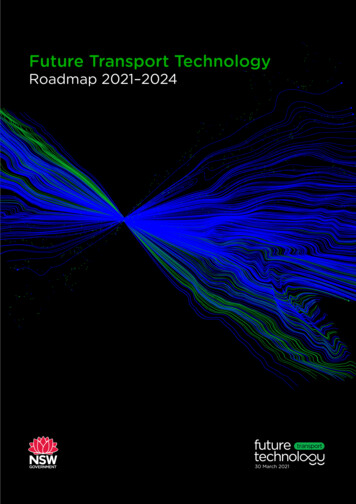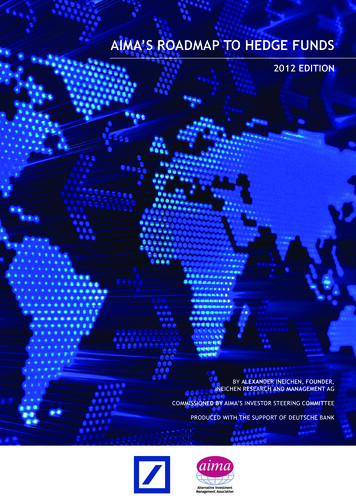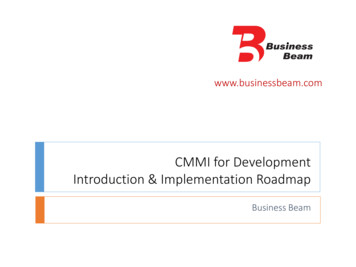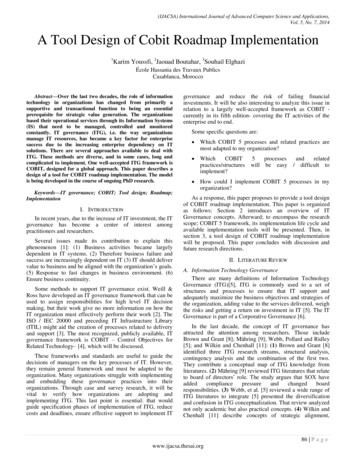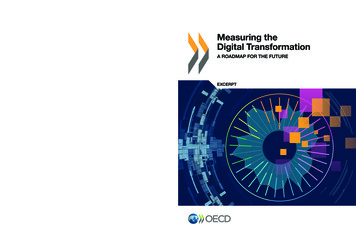
Transcription
Measuring the Digital TransformationA ROADMAP FOR THE FUTUREMeasuring the Digital Transformation: A Roadmap for the Future provides new insights into the state of thedigital transformation by mapping indicators across a range of areas – from education and innovation, totrade and economic and social outcomes – against current digital policy issues, as presented in Going Digital:Shaping Policies, Improving Lives. In so doing, it identifies gaps in the current measurement framework,assesses progress made towards filling these gaps and sets-out a forward-looking measurement roadmap.The goal is to expand the evidence base, as a means to lay the ground for more robust policies for growth andwell-being in the digital era.Measuring theDigital TransformationA ROADMAP FOR THE FUTUREEXCERPTThe charts and underlying data in this publication are available for download and most of them containadditional data expanding the time and/or country coverage of the print edition.The Going Digital Toolkit allows users to visualise and explore further key Going Digital indicators, as well as tobrowse policy guidance and related publications: www.oecd.org/going-digital-toolkit.This publication is a contribution to the OECD Going Digital project, which aimsto provide policy makers with the tools they need to help their economies andsocieties prosper in an increasingly digital and data-driven world.For more information, visit www.oecd.org/going-digital#GoingDigitalMaking the transformation workfor growth and well-beingConsult the full publication on line at http://dx.doi.org/10.1787/9789264311992-en.This work is published on the OECD iLibrary, which gathers all OECD books, periodicals and statistical databases.Visit www.oecd-ilibrary.org for more information.
Measuring the DigitalTransformationA ROADMAP FOR THE FUTUREExcerpt
This work is published under the responsibility of the Secretary-General of the OECD. Theopinions expressed and arguments employed herein do not necessarily reflect the officialviews of OECD member countries.This document, as well as any data and any map included herein, are without prejudiceto the status of or sovereignty over any territory, to the delimitation of internationalfrontiers and boundaries and to the name of any territory, city or area.Please cite this publication as:OECD (2019), "A measurement roadmap for the future", in Measuring the Digital Transformation: ARoadmap for the Future, OECD Publishing, Paris, .The statistical data for Israel are supplied by and under the responsibility of the relevant Israeli authorities. The use ofsuch data by the OECD is without prejudice to the status of the Golan Heights, East Jerusalem and Israeli settlements inthe West Bank under the terms of international law.Photo credits: Cover Sylvain Fraccola, Interactive Things and Shutterstock.Corrigenda to OECD publications may be found on line at: www.oecd.org/about/publishing/corrigenda.htm. OECD 2019You can copy, download or print OECD content for your own use, and you can include excerpts from OECD publications, databases andmultimedia products in your own documents, presentations, blogs, websites and teaching materials, provided that suitableacknowledgement of OECD as source and copyright owner is given. All requests for public or commercial use and translation rights shouldbe submitted to rights@oecd.org. Requests for permission to photocopy portions of this material for public or commercial use shall beaddressed directly to the Copyright Clearance Center (CCC) at info@copyright.com or the Centre français d’exploitation du droit de copie(CFC) at contact@cfcopies.com.
A MEASUREMENT ROADMAPFOR THE FUTUREMEASURING THE DIGITAL TRANSFORMATION: A ROADMAP FOR THE FUTURE OECD 20193
A MEASUREMENT ROADMAP FOR THE FUTUREMeasuring the Digital Transformation maps existing indicators drawn from a wide range of areas including education,innovation, trade, economic and social outcomes against current digital policy issues, as presented in Going Digital:Shaping Policies, Improving Lives (OECD, 2019). By so doing, it identifies gaps in the current measurement framework andassesses progress made by several initiatives towards filling these gaps, as documented in the 19 roadmap sections ofthe publication. The overarching objective of Measuring the Digital Transformation is to advance the measurement agendaby building on these roadmaps and a wide body of ongoing work in national and other international organisations, aswell as areas already identified in Measuring the Digital Economy: A New Perspective (OECD, 2014) and in the G20 Toolkit forMeasuring the Digital Economy (G20, 2018).1This is a challenge. Existing metrics and measurement tools struggle to keep up with the rapid pace of the digitaltransformation. The range of questions that can be asked about its impacts is daunting. How can digital transformationsbe measured and tracked in all sectors of the economy, including the public sector? How to measure the disruption ofexisting business models and the emergence of new ones, the reorganisation of work or the size of the sharing economy?How can the value of data, both private and public, be captured in standardised statistics? How can internationaltransactions of digitised goods and services be traced? How should the impact of policies on the digital economy bemonitored and assessed? What are the economic activities and jobs of the future? What are the impacts of digitaltransformations on the well-being of citizens and society at large?Much of the information required to respond to these questions already exists or is being developed, but not all. There is arecognition that statistical information systems need to adapt, and in some cases expand, to capitalise on their ability toprovide more granular insights. There is also a need for new, complementary, data infrastructures capable of tracking theemergence of new activities and monitoring their substitution for traditional ones, on a timely basis wherever these occur.Such information systems must also adapt to newly emerging digital footprints (i.e. the enormous flows of informationgenerated by digital technologies and digitally enabled activities, such as e-commerce, cloud services and the Internet ofThings) that are now being generated.In the shorter term, the challenge is to improve the international comparability of current indicators and make statistical systemsmore flexible and responsive to the introduction of new and rapidly evolving concepts driven by the digital transformation.“Even in areas where international standards to guide statistical collection exist, countries may lack the capabilitiesand resources to implement them systematically, disseminate the resulting information openly or make efforts toensure that data are comparable. There is a clear lack of coverage in developing countries compared to developedcountries due to differences in statistical capacity among countries, or user needs and priorities for statistical collection”(G20, 2018).Even among OECD countries, ensuring the international comparability of indicators used to monitor the digitaltransformation can present challenges. Only a limited number of indicators can be compiled for monitoring acrosscountries, and these are usually fairly standard and not sufficiently granular to capture the changing dynamics of thedigital transformation. Efforts to exploit official statistics at the micro level (e.g. enterprise/establishment/organisation,worker or household/individual) in an internationally co-ordinated fashion, including the use of administrative data andthe exchange of micro-data among national statistical offices (NSOs), should be supported, especially with respect todata-linking opportunities. This will mean continuing to encourage the development of tools and mechanisms to accessmicro-data while ensuring data confidentiality.A number of options exist and have begun to be explored and developed to increase the flexibility of current statisticalframeworks. These include developing and populating satellite accounts, exploiting the potential of existing microdata, adding questions to existing surveys, periodically augmenting existing surveys with topic-specific modules anddeveloping high-frequency surveys to meet specific needs. Remaining gaps could be addressed through new andexperimental approaches developed to meet the specific priorities and resources of countries (OECD, 2014).1. The 2018 Argentine G20 Presidency, in collaboration with a steering committee of international organisations (IOs) led by the Organisationfor Economic Co-operation and Development (OECD) and comprising the International Telecommunication Union (ITU), the United NationsConference on Trade and Development (UNCTAD), the European Union, the World Bank Group (WBG), the International Monetary Fund (IMF), andthe International Labour Organization (ILO), has produced a G20 Toolkit for Measuring the Digital Economy. The toolkit highlights methodologicalapproaches and indicators used to monitor the digital economy, and key gaps and challenges regarding digital economy measurement for furtherstudy. See Annex 3 of the G20 Digital Economy Ministerial Declaration, 24 August 2018, Salta, Argentina.Several international organisations are contributing to the measurement of the digital transformation through initiatives, some of which aredescribed in the G20 Toolkit for Measuring the Digital Economy. These include, but are not limited to, work on key ICT indicators within thePartnership on Measuring ICT for Development led by the ITU, UNCTAD and the United Nations Educational, Scientific and Cultural Organization(UNESCO) Institute for Statistics (UIS). The OECD works closely with several of these organisations, including the World Trade Organisation (WTO)on the issue of measuring digital trade, and the IMF on measuring the implications of the digital economy for macroeconomic statistics.4MEASURING THE DIGITAL TRANSFORMATION: A ROADMAP FOR THE FUTURE OECD 2019
A MEASUREMENT ROADMAP FOR THE FUTUREIn the longer term, the challenge for the statistical community will be to design new and interdisciplinary approaches to datacollection and to leverage the information captured by digital systems.As the digital transformation spreads across every sector and affects every aspect of society, measuring its distinctfeatures and dynamics will become increasingly challenging. New approaches will be needed – and the digital tools andfootprints created by digital activities can form part of the solution. The digital transformation is also being felt acrossall dimensions of data production and use. For example, qualitative information is increasingly becoming a source ofquantitative evidence. Text-mining tools (e.g. natural language processing) underscore the potential to alleviate someof the common challenges facing statistical collection (e.g. survey fatigue and classification systems that are applieddifferently by human coders) and offer opportunities for generating adaptable indicators. In this context, policiespromoting (open) access to data collected for administrative purposes by the public and private sectors represent animportant means to facilitate new forms of analysis.The next generation of data infrastructure for policy making in the digital era needs to build partnerships with the private sectorand engage with stakeholders to bring publicly available, reliable data into the policy-making process.The proposed measurement roadmap will have to be discussed and implemented gradually through close co-operationbetween the statistical community and other stakeholders. Policy makers will need to define user needs, while researcherscontribute insights essential for the development of appropriate metrics and data infrastructures. Engagement withorganisations, businesses, universities and the public sector will be indispensable, as the statistical system can onlycollect data that can feasibly be measured inside such organisations. In particular, private source data can open newopportunities for monitoring the digital transformation and its impacts. They can help track data flows and uses on acontinuous basis across actors, sectors and locations. For example, these data can provide insights into job vacanciesand the emergence of new jobs profiles or the new services and business models enabled by online platforms. However,the use of private source data for measurement and analysis raises new challenges that need to be overcome by workingtogether both on statistical quality frameworks and viable economic models of data sharing.The OECD and the other international organisations actively contributing to the digital measurement agenda will need tocontinue to improve co-ordination, in order to avoid fragmented efforts and initiatives and ensure that the internationalcommunity takes up the challenge to further build the evidence base for more robust policies for growth and well-beingin the digital era.Nine actions – if prioritised and implemented – would substantially advance the capacity of countries to monitor thedigital transformation and its impacts. The first four overarching actions (1 to 4) are directed towards building the nextgeneration of data and indicators capable of dealing with the challenges of the digital transformation. An additional fiveactions (5 to 9) target specific areas identified as requiring priority attention.Action 1Make the digital economy visible in economic statisticsMeasuring the digital transformation and its impacts requires the development of indicators that complement the viewsprovided by traditional measurement frameworks, such as those used to measure GDP and trade flows. But even withinthese current frameworks the way that firms, products and indeed transactions are classified and identified requiresadaptation. In addition, it is essential to accelerate efforts to capture re
digital transformation by mapping indicators across a range of areas – from education and innovation, to trade and economic and social outcomes – against current digital policy issues, as presented in Going Digital: Shaping Policies, Improving Lives. In so doing, it identifies gaps in the current measurement framework, assesses progress made towards filling these gaps and sets-out a .File Size: 2MBPage Count: 14
